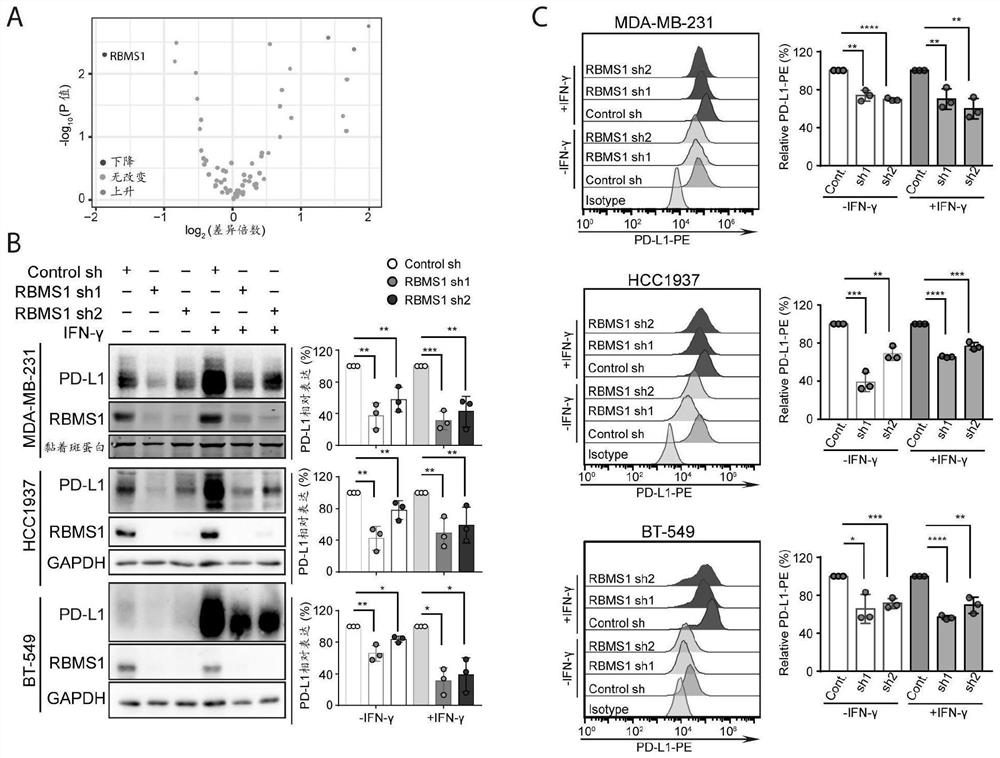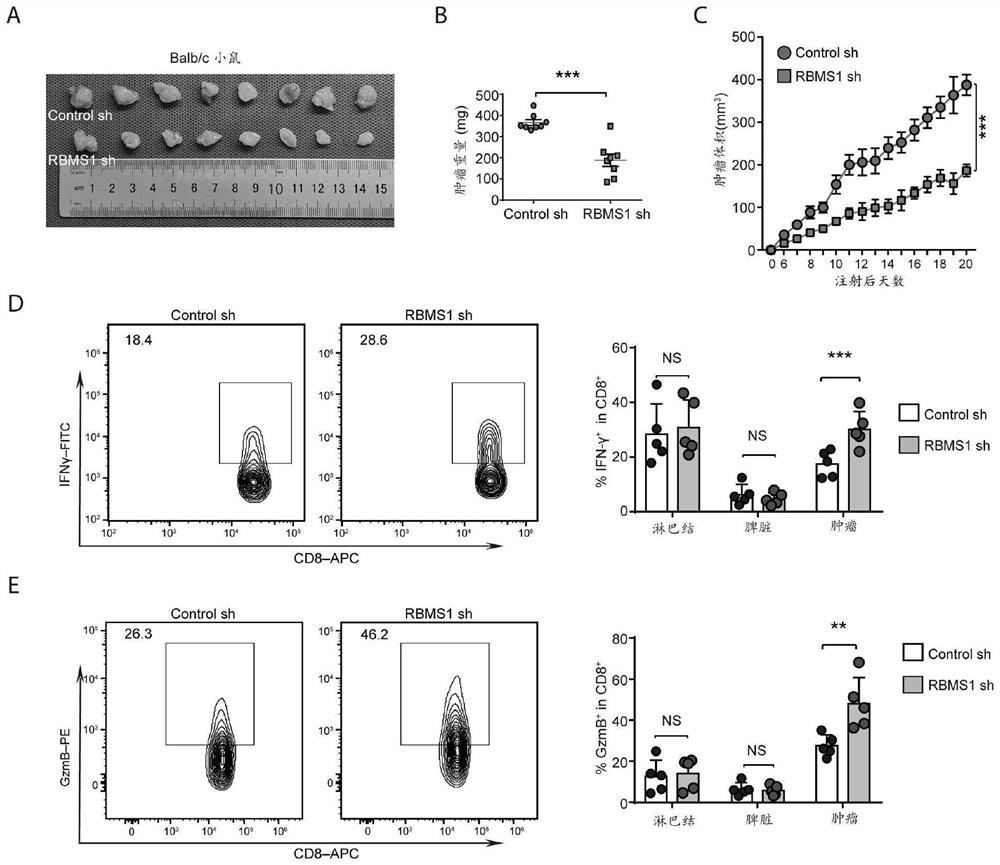Application of RBMS1 knocking-down reagent in preparation of medicine for treating triple negative breast cancer
A triple-negative breast cancer and drug technology, applied in the field of anti-tumor drugs, can solve the problems of lack of effective target molecules, inability to stimulate anti-cancer immunity, lack of triple-negative breast cancer, etc., and achieve the effect of enhancing sensitivity
- Summary
- Abstract
- Description
- Claims
- Application Information
AI Technical Summary
Problems solved by technology
Method used
Image
Examples
Embodiment 1
[0215] RBMS1 regulates PD-L1 expression in triple-negative breast cancer cells
[0216] The results of immunohistochemical staining of cancer tissues and normal breast tissues in breast cancer patient tissues showed that the expressions of RBMS1 and PD-L1 in triple-negative breast cancer tissues were higher than those in normal tissues and Her2-positive breast cancer tissues ( figure 1 In A), the expression intensity analysis of the two in different types of breast cancer, the results are as follows figure 1 As shown in B in the figure: both PD-L1 and RBMS1 are highly positive in triple-negative breast cancer (TNBC), which also reveals that RBMS1 and PD-L1 are highly expressed in most tissues of patients with triple-negative breast cancer.
[0217] figure 1 The expression of RBMS1 and PD-L1 in breast cancer patients; where, A: the expression of RBMS1 and PD-L1 was detected by immunohistochemical staining in breast cancer patients and normal breast tissues, B: breast cancer wi...
Embodiment 2
[0221] RBMS1 regulates tumor cell anti-immunogenicity and inhibits tumor growth
[0222] The established control sh and RBMS1 sh stably transformed cell lines in 4T1 cells were subcutaneously inoculated in immunocompetent Balb / c mice, and the tumor growth of the mice after tumor bearing was observed. The tumor size of the mice in the RBMS1sh group was significantly smaller than that in the control sh group. See image 3 In (A-C), the levels of interferon-γ (IFN-γ) and granzyme B (GzmB) secreted by T cells in lymph nodes, spleen and tumor were analyzed, the results showed that CD8 in RBMS1 sh group + The cells secreted gamma interferon (IFN-γ) and granzyme B (GzmB) were significantly higher than those in the control sh group, see image 3 Middle D and E.
[0223] image 3 Knockdown of RBMS1 can enhance the anti-immunogenicity of tumor cells; among them, A-C: 5-week-old female Balb / c mice were subcutaneously inoculated with 200,000 cells / mouse, and the tumor size of the mice ...
Embodiment 3
[0225] RBMS1 regulates its transcription by binding to the 3'-UTR of the glycosyltransferase B4GALT1
[0226] In order to further explore the regulation of RBMS1 and mechanistically study how RBMS1 down-regulates the expression of PD-L1, the present invention performed RNA-seq assay on RBMS1 knockdown cells in MDA-MB-231. The present invention finds that glycosyltransferase β-1,4-galactosyltransferase 1 (B4GALT1) is one of the most important proteins, and then the present invention verifies its protein level and mRNA level at the cellular level, such as Figure 4 Shown in A. B4GALT1 mRNA levels were significantly decreased after knockdown of RBMS1, Figure 4 B4GALT1 protein level was also significantly decreased after knockdown of RBMS1 in B. In order to further explore the mechanism of its regulation of B4GALT1 expression, an experiment to detect its RNA stability was carried out, such as Figure 4 In C, after adding actinomycin D to the cells for 0, 4, 8, and 12 hours, th...
PUM
 Login to View More
Login to View More Abstract
Description
Claims
Application Information
 Login to View More
Login to View More - R&D
- Intellectual Property
- Life Sciences
- Materials
- Tech Scout
- Unparalleled Data Quality
- Higher Quality Content
- 60% Fewer Hallucinations
Browse by: Latest US Patents, China's latest patents, Technical Efficacy Thesaurus, Application Domain, Technology Topic, Popular Technical Reports.
© 2025 PatSnap. All rights reserved.Legal|Privacy policy|Modern Slavery Act Transparency Statement|Sitemap|About US| Contact US: help@patsnap.com



